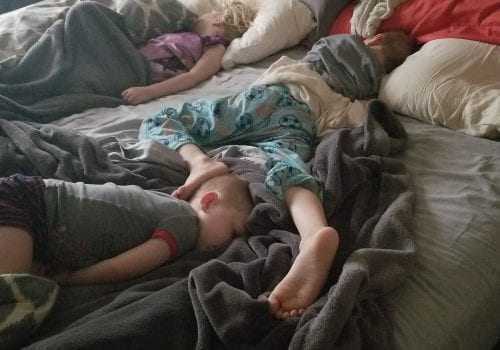
Everyone understands that sleep is an essential part of life which helps us to restore our body physically and let our brains rest and recover for the next day. But why is it so hard to get good quality sleep? Sleep is especially important for our kids, as they are growing and developing. Research suggests, “…inadequate sleep results in tiredness, difficulties with focused attention, low threshold to express negative affect (irritability and easy frustration), and difficulty modulating impulses and emotions. In some cases, these symptoms may resemble attention deficit hyperactivity disorder.” 1 As a chiropractor who treats children, this is a commonly discussed topic I address with parents with children of all ages. Ensuring your child develops a healthy sleep routine is very important and chiropractic care may help.
For young children, lack of sleep or trouble sleeping can have some serious consequences both in the short-term and long-term, including the following:
- Behavioral Issues
- Hyperactivity
- ADHD
- Stunted brain development
- Growth and developmental issues
It is no surprise that lack of sleep in our kids is normally seen alongside other issues with either physical health or behavior. Treating the root of these symptoms and treating your child’s health as a whole is what pediatric chiropractic care aims to do, and studies have shown that it can yield significant positive results.
A pilot study published in the March 2008 issue of the scientific periodical the Journal of Clinical Chiropractic Pediatrics (JCCP), showed that infants sleep better when under chiropractic care. The study was conducted in a chiropractic teaching clinic in Bournemouth, England by Dr. Joyce Miller. In the study the parents of 117 infants who were brought in for chiropractic care were asked to fill out a questionnaire on the children’s sleep behaviors. The parents were then asked to fill out follow up questionnaires on the 1st, 4th and 7th visit to the chiropractic clinic. The researchers noted that since the care took place over a 2-week period, that factors such as aging could be ruled out. In their conclusion the researchers stated, “The pilot study into the issue of sleep problems in children showed significant improvements (by parental report) in time taken to fall asleep, number of consecutive hours of sleep and depth and quality of sleep for children during a short course of chiropractic care. “
Clinicians agree that knowing the exact cause of sleeping troubles is difficult and the cause is multi-faceted. The child may have a cold or allergies, chronic pain, breathing problems, sensory dysfunction, tethered oral tissue, nutritional imbalances, behavioral or neurological issues that cause poor sleep. The child may also have a bedtime routine that unpredictable, dietary habits with high sugar, and a poor sleep environment.
We have personally struggled with sleep with my three children at one time or another. Each one of my children have struggled with and exhibits to varying degrees irritability, poor choices, frustrations, and difficulty with focus when they are sleep deprived. A change of sleep routine due to a family trip, a cold, too much electronic stimulation, and poor breathing patterns due to a tongue tie have all affected our family at one time or another. Children are human and can experience bad days too, though poor sleep can make them more frequent. We have had to become very structured with bedtime and rarely deviate because we deal with the aftermath for days later. Our children are exposed to electronics, but their time is restricted. We have given in to their demands of a later bedtime or a few more “tablet” minutes and quickly remember why we have set restrictions after our first of many meltdowns.
With all of the distractions, demands and tensions in young lives, from Facebook, Instagram, TikTok, the Internet, cell phones, video games, computers for study and entertainment and television bombarding our children, the age of instant communication even has some young people delaying sleep because they might miss something. Add these electronic distractions to a reduction in physical activity, sugar and caffeine-rich diets, and all the social pressures that accompany the developmental years, and it is easy to see why adequate healthy sleep is difficult for many young people to reach.
Researchers have identified series of negative consequences including the following2,3,4,5:
- “Poor sleepers” were significantly more likely to fail to meet requirements for their grade level;
- Fatigue caused by poor sleep or lack of enough sleep time is a strong predictor of school failure;
- Students with better grades report more total sleep on school nights than students with lower grades;
- Sleep, more than eating habits, mood, stress, time management, and social supports, accounted for the largest variance in grade point averages among college students;
- Students in high schools with earlier start times (7:40 a.m. compared to 8:30 a.m.) reported shorter school-night total sleep times, and more sleep problems, more daytime fatigue and sleepiness, more difficulties with concentration and attention, greater likelihood of using stimulants (like caffeine) to stay awake, and poorer school performance;
- Insufficient sleep is associated with school tardiness, inability to concentrate, tendency to doze off during class, and lowered school motivation.4
The consequences of sleeping problems are widespread. They impact health, growth, behavior, and school performance.
Here are some tips to consider in your child’s environment to improve sleep:
- Mattress Support & Size: It is important to have a medium firm support. Also, did you know that children move 35 to 60 times each night! A mattress that is too small can cause sleep disturbances.
- Room Colors: Choose calmly, muted tones for your child’s bedroom to aid in a relaxing space.
- Room temperature: 65 degrees may be the best for achieving a restful sleep, some studies suggest. Improper body regulation may cause restfulness. Kids tend to run “hot” so make sure you are not over-dressing or keeping the room too hot. Of course, we each have slightly different temperatures for sleep, so experimenting with different temperatures to find what may make you or your children most comfortable would be recommended. 6
- Modify the diet: High sugar, caffeine, and going to bed hungry can inhibit sleep.
- Noise: Reduce noise and stimulation before bed. Electronics should be turned off at least 30-60 minutes before bedtime.
- Routine: Be prepared to deal with resistance. It is in a child’s nature to want to stay up later. By establishing a regular routine, they will know what to expect.
If your child wakes up at the same time every night investigate his/her sleep environment and see what may be waking them up. It may be the A/C, heat, streetlight, noisy neighbor, snoring/difficulty breathing, or hunger.
So how can chiropractic help? Pediatric chiropractors are experts in assessing, treating, and identifying issues for a range of health conditions. After a thorough assessment, adjustments that are specifically designed for pediatric patients are used to relieve any joint and/or muscular restriction may be present. Exercises and potential referrals to other community professionals may be provided. As I mentioned earlier, it is typically more than just one thing causing sleep disturbances, but a multi-faceted issue.
Raising children is hard and finding a good night sleep is sometimes harder, but it doesn’t have to be with some a solid routine and an understanding of each child’s needs. Otherwise, when the going gets tough, you can always call grandma!
We are always here at Venture to help provide support, educate, and take care of your family. We want every member of your family to move better, feel better, and be better!
–Melanie Dockter CACCP, DC
References:
- Ronald E. Dahl, “The impact of inadequate sleep on children’s daytime cognitive function, “Seminars in Pediatric Neurology, Pages 44-50, March 1996.
- Gozal D, Keirandish-Gozal L. Neurocognitive and behavioral morbidity in children with sleep disorders. Curr Opin Pulm Med, 2007;13(6):505-9.)
- Quach, Jon, BSc, Hiscock, Harriet, MD, Canterford, Louise, GDipSci(Stats), Wake, Melissa, MD “Outcomes ofChild SleepProblems Over the School-Transition Period: Australian Population Longitudinal Study,”PEDIATRIC SVol. 123 No. 5 May 2009, pp. 1287-1292 (doi:10.1542/peds.2008-1860.
- Wolfson, Amy R. and Carskadon, Mary A, “Understanding adolescents sleep patterns and school performance: a critical appraisal,” Sleep Medicine Review, 2003; 7 (6):491-50.
- Breus, Michael J, PhD, MD, “Back to School, Back to Sleep: Fixing your children’s sleep problems may improve their grades and their behavior,” www.WebMD.com.
- https://www.sleepfoundation.org/bedroom-environment/touch/what-temperature-should-your-bedroom-be




